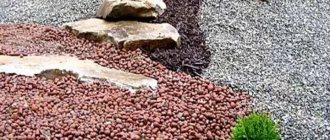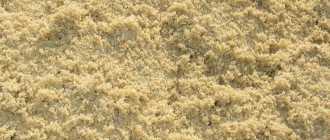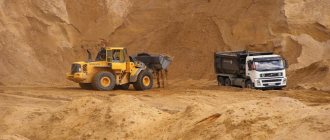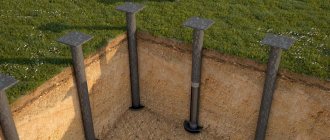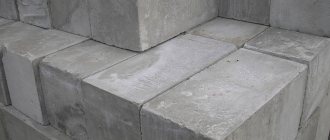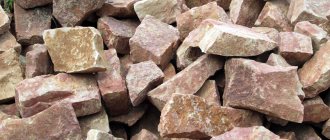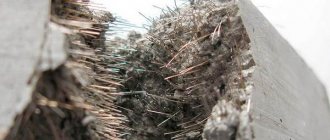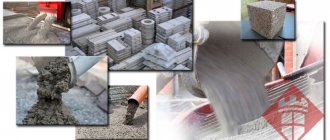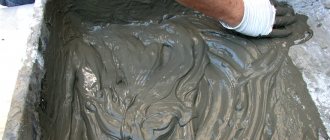Types of gravel
Types of gravel
This material has 3 main varieties according to the characteristics of its origin: mountain, glacial and water. The mountain variety of gravel occurs when rocks are destroyed under the influence of external factors. The river variety is associated with its accumulation in river beds, at the bottom of lakes and near the seashore. Under the influence of moving water and sand, pieces of rock are ground down to form gravel.
The glacial variety is associated with the movement of a glacier. When rocks are ground together, gravel is formed. Its particles in this case retain their rough shape. The internal structure of glacial gravel is relatively homogeneous. This material is used in various areas of construction, including those where increased demands are placed on structural strength.
In mountain gravel, the particle breakdown is even lower. It contains a large amount of clay, dust and other contaminants. It is often used in road construction, including when creating embankments and a reinforcing layer for railway tracks.
According to the characteristics of the material, it is divided into: construction, small, decorative, white, shungizite, silicon, rounded, washed.
Construction gravel can have various characteristics that do not go beyond the following values:
- particle size ranges from 3 mm to 7 cm;
- The density of gravel can be from 1.4 to 3 g/cm3.
The strength of construction gravel depends on its brand. The radioactivity indicator is also determined for it, on which the possibility of safe use in housing construction depends.
Decorative gravel is often used to create spectacular designs in garden plots. This gravel comes in a wide variety of colors.
Decorative gravel
White gravel is used in flower beds to make plants stand out more clearly against the general background. The garden area decorated with white gravel looks neat and elegant. In addition to its aesthetic function, it also helps in solving some problems: it reduces the likelihood of weeds, reduces cooling and overheating of the soil, reduces water evaporation, which allows you to reduce the frequency of watering, and accelerates the absorption of rain into the soil.
Pea gravel is a mass of grains of minerals and rocks, the diameter of which is less than 0.7 cm. It is mainly used in road construction. It is also mixed into concrete or used in landscape design. Pea gravel comes in a variety of colors and shades.
Shungizite gravel is considered a good thermal insulation material. It is used as a porous filler.
Silicon gravel is used as a filter for water that may contain harmful substances. Well suited for use in wells.
Particles of the same gravel can be representatives of different rocks and minerals. This is due to their different colors and other features. Also, pieces of this material vary in size and degree of smoothness.
The most common mineral in gravel is silica. Manganese, iron, potassium and other components are found in small quantities.
Washed gravel differs from its other varieties in the absence of unnecessary impurities. It is mined in rivers and on the seashore. Special technologies are used during extraction. It is mainly used to produce concrete.
Washed gravel
What is gravel
Gravel is a sedimentary rock of mountain origin, the composition of which is very heterogeneous. In nature you can find different types of gravel, ranging from mountain gravel to sea gravel. This feature of this material greatly influenced its physical and mechanical properties; each type of gravel has its own.
Gravel is extracted using special equipment. After transportation, the material undergoes careful calibration, during which the gravel is screened by size. In some cases, if production requires it, the gravel is washed to remove clay, sand and various other inclusions.
Based on the fraction, there are three types of gravel:
- Gravel measuring 1-1.25 mm is considered fine;
- Sizes up to 5 mm are considered medium;
- Gravel over 10 mm is considered coarse.
Since this inert material is mined in different places, there are several varieties.
Types of gravel
Mountain gravel differs from other types of gravel in its rough and sharp surface with a large inclusion of various impurities. Today, mountain gravel is most widely used in road construction.
River gravel has a smooth surface and rounded shapes. During the production process, river gravel is often crushed to increase its adhesive properties. This is the most popular type of gravel, which is distinguished by its strength, both in crushability and frost resistance.
Sea gravel - this type of gravel differs from all others in its polished surface and minimal amount of foreign inclusions.
In addition, gravel differs depending on the application. For example, there is decorative gravel, which is widely used in landscape design, and white gravel, which allows not only to decorate the local area, but also to slow down the growth of weeds in flower beds.
Properties of gravel
Gravel has good density and compressive strength. In addition, the excellent frost resistance of this material should be highlighted.
Below are the main physical and mechanical properties of gravel:
- Compressive strength, not less than 1.5 t/cm2;
- Frost resistance F15-F200;
- Gravel density, from 1.4 to 3 g/cm3;
- Weight, 1400 kg per cubic meter;
- Fraction size, from 3-150 mm.
Gravel is considered one of the most durable inert materials, which is widely used in construction.
Characteristics of natural gravel
Basically, this material is classified according to characteristics that are important for the construction and operation of structures.
- Particle size. Based on this criterion, 5 categories of gravel are distinguished: with particle sizes from 0.5 to 1 cm, 0.5 - 2 cm, 1 - 2 cm, 2 - 4 cm, 4 - 7 cm.
- Strength and mechanical stability. They depend on the composition and crystalline structure of the particles and are of great importance when choosing this material for use in road construction.
- Impurity content. These mainly include dust and clay. The gravel extracted from mining and dry river beds has the most impurities, while the gravel extracted from water bodies has the least amount of impurities.
The content of harmful impurities is taken into account separately. Such impurities can significantly deteriorate the quality of concrete and cause corrosion. Some harmful impurities can be toxic and also affect background radiation.
- Resistance to temperature fluctuations.
Properties of gravel
Natural gravel is a natural material, the formation of which occurs during the destruction of rocks (including under the influence of wind). There are several types of occurrence of raw materials, therefore river gravel, sea gravel, lake gravel, gully (mountain) and even glacial gravel are distinguished. The properties of mountain gravel are determined by its somewhat rough surface, as well as the presence of dust, sand, clay, organic substances and other impurities. A sand-gravel mixture is considered to be a material in which the percentage of sand is 20-40 percent.
River and sea gravel are cleaner in composition. But it has a smoother surface, which leads to poorer adhesion to fasteners.
Most often, the choice of builders is mountain gravel, because its technical qualities are better than those of other types of material. It is used to build foundations, highways, backfill various sites, and make roofing materials.
Gravel has several shades: white, black, brown, gray-white, gray-blue, pink. The color of the material may change slightly due to exposure to humidity and lighting. Therefore, it is often used in landscape design: during the design of a summer cottage, when arranging garden paths, for laying out flower beds.
The possibility of using gravel depends on the physical and technical qualities of the material (they are regulated by technical instructions and GOSTs).
GOST 82 67 93 is developed for crushed stone and gravel , which has a granule density of 2-3 grams per cubic centimeter. It is used for construction work of any kind, including the production of heavy concrete and road construction.
An extract from this standard states that gravel can be considered a granular material with an inorganic base with a granule size greater than 5 mm. Formation occurs during sieving of the gravel-sand mixture.
Main properties of gravel:
• There are several types of material (depending on density). The average is 2.5 - 2.7 tons per meter. cube The bulk density value is in the range of 1.42 - 1.62 tons per cubic meter. • Specific gravity – up to 1400 kg/m. cube, volumetric – 1600 kg/m. cube • Possible grain shapes: angular, rounded, rounded-angular. GOST 8267-93 also states that gravel can have up to 35% of the total mass of grains with an angular or lamellar shape. • There are several grades of material (depending on compression or crushing in the cylinder). Existing strength grades: DR 24, DR 16, DR 12, DR 8. • If gravel is used in road construction, then the abrasion measure is important. It is determined after testing in a shelf drum. There are grades I-IV, I-III, I-II, I-I. • Frost resistance grades: F15 - F400.
You might be interested:
- Gravel
- Gravel fraction 5-20 mm
- Crushed stone
- Crushed granite fraction 2-5
Gravel mining
Gravel mining
Most often, gravel is mined from river beds and from coastal sediments. Less commonly, it is obtained from quarries, where it is mixed with sand, clay and other minerals. Excavators, bulldozers and other mechanisms are used for quarrying. The extracted mass is transported to special factories, where impurities are removed and particles are distributed by size. Trucks and trains are used for transportation.
What is gravel used for?
In the modern world, a large number of different building materials are used. One of the most popular building materials is gravel .
This natural material consists of the remains of mountainous and volcanic rocks, among which sand and expanded clay . Various special equipment is used to extract gravel. The use of a specific type of such equipment depends on the location of gravel extraction. This can be a mountainous, river or sea area. The use of gravel is very popular in construction today. Gravel is granular in structure. The cost of gravel is relatively low, which allows various construction companies to purchase this bulk material in huge volumes. Very often, gravel is used to form landscapes, as well as to make concrete. A very useful feature of river or sea gravel is the smoothness of its fractions. This effect is achieved by grinding it with water. This feature allows the use of gravel for the manufacture of certain concrete structures. The strength of concrete will become lower. But such concrete is perfect for creating artificial ponds, huge aquariums and other various products required in landscape design. Sea gravel has very beneficial properties. It contains a lot of iodine and also contains a large number of microelements.
Gravel has many very important uses. Mountain or ravine gravel is used to strengthen the banks. This material is actively used for backfilling road surfaces. Many people use this building material to create beautiful decor. Quartz gravel is often used to filter pools. Gravel is also to create beautiful decorative surfaces. A very beautiful effect is created. The diverse properties of gravel allow it to be used in a wide variety of areas of the construction industry. This wonderful material is accessible to absolutely everyone. Thanks to the improvement and modernization of modern technology, gravel began to be mined in much larger volumes. In specialized industries where gravel is processed, many technical processes have also improved. This trend has allowed for more efficient use of this building material. The extraction of gravel is a very profitable business, because this material is in great demand.
You might be interested:
- Crushed gravel in bags 5-20
- River sand
- Crushed stone
- Crushed granite
Main areas of use
The ease of extraction and the high prevalence of natural gravel make it available for use in various areas.
Most often this material is used for the production of concrete. This is especially true for quarry gravel, the particles of which have an uneven surface and resemble pieces of rock, rather than smooth, rolled pebbles. Such gravel binds better to concrete, which gives the latter high strength. The second condition for using gravel for concrete production is resistance to alkaline environments.
It is also often used in the construction of roads and railways. At the same time, it must satisfy such requirements as strength, mechanical and temperature stability.
The use of gravel for decorating garden plots and flower beds is gaining momentum. The fine fraction of this material is used to fill paths and rest areas. In this case, it is necessary that the gravel grains are smooth and rolled. The variety with larger particles is used to improve the appearance of ponds, flower beds and squares.
Gravel for the garden
What are the differences between gravel and crushed stone?
Gravel and crushed stone are pieces of minerals and rocks. Their main difference is related to receiving. Gravel is obtained by direct extraction, without mechanical transformation. Its formation depends entirely on the action of natural forces.
To obtain crushed stone, larger fractions of rocks are used. These pieces are then crushed, resulting in the formation of crushed stone. Externally, it differs from gravel in the large number of sharp corners and lack of rolling. The material for its production can be rock dumps, waste, rock blocks.
Construction gravel
In addition to ordinary fine gravel, gravel is used in construction, the size of which varies from 3 to 70 mm. The size of non-standard construction gravel can reach up to 150 mm. The density of construction gravel depends on the source from which it was obtained.
Construction gravel has increased strength. To carry out different types of work, different brands of construction gravel are used. Also, different brands of gravel may have different degrees of radioactivity, which completely depends on the material of the gravel. This parameter turns out to be very important. On its basis, the environmental safety of the material is determined, and, consequently, the possibility of its use on various construction sites.
The most durable gravel used in construction is granite gravel.
